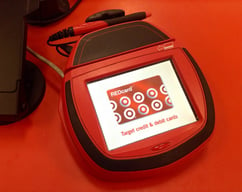

Can you believe that we’re coming up on the two-year anniversary of the massive 2013 Target data breach? It may not feel that way because we’re still seeing news articles pop up regarding the aftermath of the incident, but it’s true. Comparing Target’s stock price before the breach ($62) and two years after it ($82), it might be tempting to think that the company is breezing through the effects of the one of the most publicized corporate cybersecurity disasters of the decade. However, it’s been a long road to recovery for Target and it’s not over yet. What can we learn from two years of Target’s data breach recovery?
 The Target data breach has gained notoriety mostly because of the complete PR disaster it created for Target right around the holiday season. Famous security blogger Brian Krebs broke the breach news back in December 2013, revealing that Target had been hiding news from vulnerable customers. The breach was shrouded in mystery for some time before Target got its PR affairs in order and there has still been some confusion even two years later.
The Target data breach has gained notoriety mostly because of the complete PR disaster it created for Target right around the holiday season. Famous security blogger Brian Krebs broke the breach news back in December 2013, revealing that Target had been hiding news from vulnerable customers. The breach was shrouded in mystery for some time before Target got its PR affairs in order and there has still been some confusion even two years later.
The results of a confidential investigation by Verizon into Target’s cyber security situation days after the breach were recently revealed, uncovering many of the data breach mysteries. In hindsight, here’s what happened when Target was attacked:

After two years, Target has finally settled its lawsuit with Visa and is working on settling with MasterCard—they are moving on and have become somewhat of a leader in cyber security. Target has bounced back from a brutal data breach that was only partially covered by cyber insurance and there are multiple things to learn from their recovery:
Target has spent a fortune updating their PoS registers and bolstering their cyber defenses—even going so far as to create a top-of-the-line cyber fusion center. If there’s one thing to learn from the Target breach, it’s that preparation is key. Preparation requires you to provide your security appliances with 100% network visibility, knowing your baseline traffic and being able to continuously spot deviations from the norm.
The only way to ensure 100% network visibility is to implement network TAPs when connecting security appliances. Learn from Target’s 2013 mistakes—invest in the right security appliances and enable them to see the traffic necessary to protect your network.
If the inline security tool goes off-line, the TAP will bypass the tool and automatically keep the link flowing. The Bypass TAP does this by sending heartbeat packets to the inline security tool. As long as the inline security tool is on-line, the heartbeat packets will be returned to the TAP, and the link traffic will continue to flow through the inline security tool.
If the heartbeat packets are not returned to the TAP (indicating that the inline security tool has gone off-line), the TAP will automatically 'bypass' the inline security tool and keep the link traffic flowing. The TAP also removes the heartbeat packets before sending the network traffic back onto the critical link.
While the TAP is in bypass mode, it continues to send heartbeat packets out to the inline security tool so that once the tool is back on-line, it will begin returning the heartbeat packets back to the TAP indicating that the tool is ready to go back to work. The TAP will then direct the network traffic back through the inline security tool along with the heartbeat packets placing the tool back inline.
Some of you may have noticed a flaw in the logic behind this solution! You say, “What if the TAP should fail because it is also in-line? Then the link will also fail!” The TAP would now be considered a point of failure. That is a good catch – but in our blog on Bypass vs. Failsafe, I explained that if a TAP were to fail or lose power, it must provide failsafe protection to the link it is attached to. So our network TAP will go into Failsafe mode keeping the link flowing.
Single point of failure: a risk to an IT network if one part of the system brings down a larger part of the entire system.
Heartbeat packet: a soft detection technology that monitors the health of inline appliances. Read the heartbeat packet blog here.
Critical link: the connection between two or more network devices or appliances that if the connection fails then the network is disrupted.